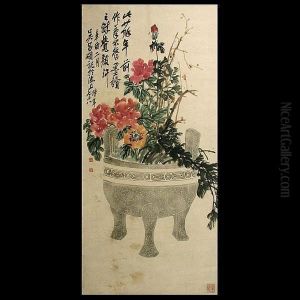Wu Changshao Paintings
Wu Changshao, born Wu Junqing in Zhejiang Province, China, was a prominent Chinese painter, calligrapher, and seal artist of the late Qing Dynasty. His artistic journey is a testament to the dynamic interplay between tradition and innovation that characterized the period. Wu initially embarked on his career under the name Wu Junqing, but he is best known by his art name, Changshao. His early life was steeped in scholarly pursuits, but it was in the arts that he found his true calling. Wu's artistic talents were not confined to a single discipline; he excelled in painting, calligraphy, and the intricate art of seal carving, making significant contributions to each field.
Wu Changshao's painting style evolved over the years, ultimately embodying the essence of the Shanghai School, which sought to rejuvenate traditional Chinese art by infusing it with new vitality and incorporating Western techniques. He is particularly renowned for his floral paintings, which showcase his ability to capture the spirit of his subjects with bold strokes and vibrant colors, a departure from the more subdued tones traditionally used in Chinese ink painting. This innovative approach not only won him acclaim during his lifetime but also influenced subsequent generations of artists.
In addition to his achievements in painting, Wu Changshao was a master calligrapher, known for his unique style that seamlessly blended the rigid structure of clerical script with the fluidity of running script. His calligraphy, much like his paintings, reflects a deep respect for tradition, yet is characterized by a distinct personal flair that sets his work apart.
Wu's expertise in seal carving further solidified his status as a renaissance man of the Chinese arts. He revitalized this ancient art form, treating seals as works of art in their own right rather than mere tools for imprinting. His seals are celebrated for their innovative designs and the skillful integration of calligraphy and imagery, making them highly sought after by collectors.
Wu Changshao's legacy extends beyond his artistic achievements. Through his teaching and leadership in artistic societies, he played a crucial role in nurturing a new generation of artists, shaping the future of Chinese art. His life and work embody the spirit of innovation within the framework of tradition, making him a pivotal figure in the transition from the Qing Dynasty to modern Chinese art. Wu Changshao's contributions to painting, calligraphy, and seal carving have left an indelible mark on the cultural heritage of China, celebrated to this day for their beauty and originality.
